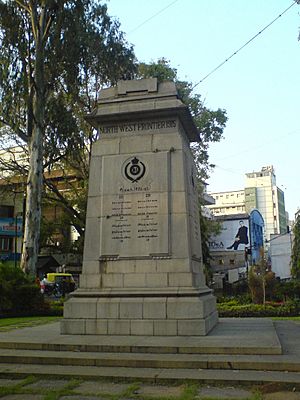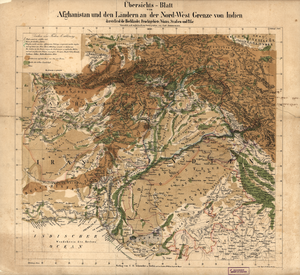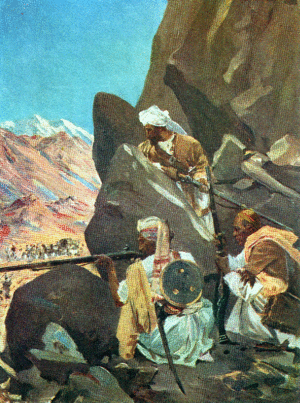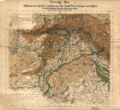Military history of the North-West Frontier facts for kids
The North-West Frontier was a special area in the British Indian Empire, which is now called Khyber Pakhtunkhwa in Pakistan. It's like a natural border on the western side of Pakistan, stretching from the high Pamir Knot mountains in the north to the Koh-i-Malik Siah in the west. This area separates Pakistan from its neighbor, Afghanistan.
The official border line between them is called the Durand Line. It divides the Pashtun communities, who live on both sides of this border.
Two very important mountain passes in this region are the Khyber Pass and the Bolan Pass. For thousands of years, people have traveled and even invaded the Indian subcontinent through these routes. Later, when the Russian Empire started expanding into Central Asia, controlling this Frontier and Afghanistan became super important for the British to protect their Indian Empire.
A big part of this Frontier was taken over by Ranjit Singh in the early 1800s. Then, the East India Company (a powerful British trading company that also ruled parts of India) took control of it in 1849 when they took over Punjab.
From 1849 to 1947, the history of this border was full of military actions. The British often sent forces to deal with local Pashtun tribes. There were also three major wars against Afghanistan. Many British officers who later became famous generals in World War I and World War II learned their military skills here. They even called the North-West Frontier the Grim because it was such a tough place to fight.
Contents
- Who Was Involved?
- Timeline of Conflicts
- 1526–1757 (Mughal-Afghan Wars)
- 1800–1837 (Afghan-Sikh Wars)
- 1838–1848 (First Afghan War to Second Sikh War)
- 1849–1858 (Second Sikh War to Sepoy Revolt)
- 1859–1878 (Sepoy Revolt to Second Afghan War)
- 1878–1898 (Second Afghan War to Frontier Rebellion)
- 1898–1914 (Frontier Revolt to Great War)
- 1914–1918 (First World War)
- 1919–1939 (Between the Wars)
- 1940–1947 (Second World War to Independence)
- Withdrawal
- Military Groups
- See also
- Images for kids
Who Was Involved?
Afghanistan
In 1747, a leader named Ahmad Shah Durrani took control of important cities like Kandahar, Kabul, and Peshawar. He became the Shah (king) of the Afghans and built a large empire that stretched from the Oxus River to the Indus River. When he passed away in 1773, his empire included areas like Baluchistan, Sindh, Punjab, and Kashmir.
His son, Timur Shah Durrani, took over, but the Afghan empire started to shrink. After Timur died, his many sons fought for the throne for over 30 years. During this time, the Punjab region was lost to Ranjit Singh, and other areas like Khorassan and Sindh also broke away. By 1823, even Peshawar, their winter capital, was under attack.
In 1826, Dost Mohammad Khan became the undisputed ruler in Kabul and was named Emir. He fought off rivals, but the Sikhs took over all of Peshawar in 1834. In 1837, Dost Mohammad tried to get Peshawar back through the Khyber Pass but was stopped. He asked the East India Company for help against the Sikhs, but they said no. So, he turned to Imperial Russia for support.
Sikh Empire
Maharaja Ranjit Singh was a powerful Sikh ruler who led the Sikh Empire in Punjab. His resting place is in Lahore, Pakistan.
He spent many years fighting the Afghans, pushing them out of western Punjab. He took advantage of the Afghans being busy with their own civil wars. The former Afghan king, Shuja Shah Durrani, who had been removed from power, gathered many tribes and got help from the British and the Sikh army against Dost Muhammad. Because of this civil war and the British-backed attack, the Sikhs were able to easily take over Peshawar. They captured Pashtun lands, including Peshawar, which then came under direct British control.
British East India Company
At the start of the 1800s, the East India Company controlled a large part of southern India, as well as Bengal, Bihar, and Orissa (now Odisha). They became the main power in India, beating out the French trading company. Britain and France were at war, and when France made alliances with Persia and Russia in 1807, the East India Company became worried about threats from the north-west.
By 1819, only Sindh and the Sikh Empire were not under the Company's control. Even though Napoleon was defeated, the Russian Empire started expanding south and east. Russian influence grew, and by the early 1830s, Iran was under Russia's influence. When Iran tried to take Herat in 1834 and again in 1837, it made the British fear that Russian armies might reach Kandahar, which would give them direct access to India through the Khojak Pass and Bolan Pass.
Meanwhile, the fight between Afghanistan and Punjab focused on the Khyber Pass. Dost Mohammad asked the East India Company for help to get Peshawar back. But the Company couldn't help him without upsetting their ally, Ranjit Singh. When Dost Mohammad then asked Russia for help, the British Governor-General, Lord Auckland, decided to remove Dost Mohammad from power. He wanted to replace him with Shuja Shah Durrani, the exiled former ruler. The idea was that Shuja Shah, once back on the throne in Kabul, would accept the Sikh gains west of the Indus and let the Company control Afghanistan's foreign policy. This agreement was made official with the Treaty of Simla in June 1838, signed by Shah Shuja, the East India Company, and Ranjit Singh.
British Indian Empire
The British Raj was the period of British rule in India. After the East India Company, the British government took direct control.
Timeline of Conflicts
1526–1757 (Mughal-Afghan Wars)
- Battle of Malandari Pass
1800–1837 (Afghan-Sikh Wars)
- Battle of Nowshera (1823)
- Battle of Akora Khattak
- Battle of Bannu
- Battle of Jamrud (1837)
1838–1848 (First Afghan War to Second Sikh War)
- First Anglo-Afghan War (1838–1842)
- Sindh Campaign (1843)
- First Anglo-Sikh War (1845–1846)
- Second Anglo-Sikh War (1848–1849)
1849–1858 (Second Sikh War to Sepoy Revolt)
After the British took over Punjab in 1849, there were many military actions against almost every tribe along the North-West Frontier. Famous leaders like Sir Charles Napier and Sir Colin Campbell led some of these. They were ordered to burn Pathan villages, but they didn't like these orders and resigned. Campbell believed that giving gifts was a better way to deal with the tribesmen than fighting.
When the Sepoy Rebellion (also known as the Indian Mutiny) started, Amir Dost Mohammad Khan was pressured to attack India. But he kept his promise and stayed neutral. This allowed British Indian troops from the frontier to go to Delhi and help put down the rebellion there.
- Many smaller military operations took place against different tribes.
- Sepoy Rebellion (1857–1858) (Indian Mutiny)
1859–1878 (Sepoy Revolt to Second Afghan War)
- Many smaller military operations continued against various tribes.
1878–1898 (Second Afghan War to Frontier Rebellion)
In 1877, Amir Sher Ali of Afghanistan welcomed a Russian group to Kabul but refused a British one. The next year, Sher Ali signed a treaty with Russia. The British sent a group anyway, but they were not allowed to pass through the Khyber Pass. The British threatened to invade, and when no apology came, they did. Sher Ali died while trying to escape to Russian territory, and his son Yakub became the new Amir. On May 26, 1879, Amir Yakub signed the Treaty of Gandamak. This treaty meant Afghanistan gave control of its foreign policy to the British Empire, who in return promised to protect Afghanistan. Afghanistan also gave up some land and accepted a British official in Kabul.
In September 1879, just six weeks after the British official arrived, he and his guards were killed. Fighting started again. Yakub's army was defeated in September 1880, and the throne was offered to Abdur Rahman. He accepted and agreed to give up all claims to the Khyber, the Kurram, Sibi, and Pishin areas.
- Second Afghan War (1878–1880)
- Many smaller military operations continued.
- Siege of Malakand (1897)
- Tirah Campaign (1897)
1898–1914 (Frontier Revolt to Great War)
- Mahsud Waziri blockade (1900–1902)
- Bazar Valley campaign (1908)
- Mohmand Expedition of 1908
1914–1918 (First World War)

During World War I, the Indian Army sent soldiers to fight in Europe, Africa, and the Middle East to help the British. This made India vulnerable to attacks from Afghanistan. A group from Turkey and Germany arrived in Kabul in October 1915, clearly with military plans. However, Amir Habibulla kept his promise and kept Afghanistan neutral, even though some groups wanted to side with the Ottoman Sultan. Fighting on the frontier remained small and local.
- Operations in the Tochi (1914–1915)
- Operations against the Mohmands, Bunerwals and Swatis (1915)
1919–1939 (Between the Wars)
After keeping Afghanistan neutral during the Great War, Habibulla wanted full independence for Afghanistan in February 1919. This might have made his rule stronger, but he was murdered later that month.
His successor, Amanullah, tried to achieve independence in a different way. With India's army being reduced after the war and its government busy with unrest, Amanullah sent his troops across the Frontier in early May. By the end of the month, he asked for a ceasefire, which was granted on June 3. By the Treaty of Rawalpindi signed in August, Afghanistan gained control of its foreign affairs. In return, it recognized the Durand Line as its border with India.
This short war had big effects in Waziristan, where local tribes joined Amanullah's cause. Many military posts were abandoned, and soldiers deserted, taking their weapons to join their tribesmen in attacking other posts. As a result, the Indian Army had to spend from November 1919 to May 1920 re-establishing these posts and securing supply routes.
The long-term plan to control the area involved building paved roads to a new main base at Razmak. Work began in 1921. By 1924, the roads met, connecting North Waziristan and South Waziristan. This allowed the Indian Army to organize both areas as one military district.
- Third Anglo-Afghan War (1919)
- Operations in Waziristan (1919–1920)
- Operations in Waziristan (1921–1924)
- Pink's War (1925) (This was an operation where aircraft were used to subdue tribes.)
- Afridi Redshirt Rebellion (1930–1931)
- Operations in Waziristan (1936–1939)
1940–1947 (Second World War to Independence)
From 1940 to 1947, during World War II, Waziristan and most of the Frontier region stayed fairly calm. This allowed the British to send most of their soldiers to other important war zones. However, there were still short periods of trouble that required the British to keep some military presence there.
In 1944, a British committee suggested a plan to pull back all regular soldiers from tribal areas to outposts along the border. The local militias would then be responsible for security in their own districts.
Withdrawal
In 1947, after India became independent, the North-West Frontier region became part of the new country of Dominion of Pakistan. Following the recommendations from the 1944 British committee, the new Pakistani government decided to change the old British policy. They ordered the withdrawal of forces from Waziristan, believing that the presence of regular soldiers was causing tension with the local tribesmen. This withdrawal began on December 6, 1947, and was successfully completed by the end of the month.
Military Groups
Over time, different military groups were formed to manage the North-West Frontier.
Corps of Guides
The Corps of Guides was a special military unit made up of both cavalry (soldiers on horseback) and infantry (soldiers on foot). It was created in Peshawar in 1846. These soldiers were unique because they were the first troops to wear khaki uniforms. Khaki is a dull, earthy color that helped them blend in with the rocky landscape, acting as camouflage. This color was very useful on the North-West Frontier, and soon other units copied them.
The Guides were involved in many conflicts on the frontier and earned several battle honors. They were famous for their speed; in 1857, they marched 930 kilometers from Mardan to Delhi in just 22 days to help put down the Sepoy Revolt, and went straight into battle when they arrived.
Sind Frontier Force
This force was created in 1846 to protect the southern part of the North-West Frontier. It included cavalry units like the Scinde Irregular Horse, which earned honors in various campaigns.
Frontier Brigade
Formed in 1846, this brigade was created to police the newly acquired Punjab border against the Pakhtun hill tribes. It was made up of four infantry regiments.
Transfrontier Brigade
Formed in 1849, this brigade also included cavalry and infantry regiments.
Punjab Irregular Force
This force, often called Piffers (from its initials), was formed in 1851 by combining several existing units, including the Corps of Guides and the Frontier Brigade. They were known for being tough and experienced fighters. Many of their units helped put down the Sepoy Revolt.
Punjab Frontier Force
In 1865, the Punjab Irregular Force was renamed the Punjab Frontier Force. This force was very important to the British Governor-General and was known as the most experienced fighting group in India. They were involved in many border expeditions and saw a lot of action during the Second Afghan War.
Frontier Constabulary
The Frontier Constabulary was a police force that helped maintain order in the region.
Frontier Corps
The Frontier Corps was a group of military units, often called 'Scouts'. These units were formed over time to meet specific needs on the frontier. The term 'Scouts' was chosen because it suggested enthusiasm, expertise in local conditions, and familiarity with the terrain.
The Scouts understood the local area and the people very well. They knew which tribes could be trusted and which were often hostile (like the Mahsuds). They also knew who might be upset or who had just had a problem solved and might be friendly.
Over the years, many different Scout units were formed, often drawing recruits from the local tribal areas. For example, the Khyber Rifles recruited from tribes near the Khyber Pass, and the Kurram Militia recruited from tribes in the Kurram Valley.
See also
- Military history of Pakistan
- List of Pashtun empires and dynasties
- Bannu District
- Gomal River
- Kohat Pass
- Tank
Images for kids
-
Map of the present-day Khyber Pakhtunkhwa province (green), previously the North-West Frontier; and FATA (purple)
-
Madras Regiment War Memorial, Bangalore, mentions lives lost in the North West Frontier by the Madras Sappers







